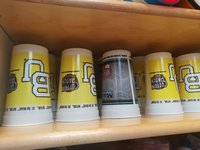AlexBaylor
New member
- Joined
- Jul 22, 2019
- Messages
- 19
There is an empty cabinet that needs to get filled with cups. It can fit three rows of five with two cups high. With thirty gray and thirty yellow cups at your disposal, how many possible combinations of cups (that don’t use more than thirty cups total) are there that don’t fulfill the pattern? Show your work.
Pattern Rules
*Only the completely visible cup (One cup high then that cup, otherwise just the top cup) counts
Example of a working pattern...

Pattern Rules
- The middle spot in each row must be empty or gray*
- The other spots must be empty or yellow*
- Each row across must be symmetrical by height (0 cups, 1 cup, 2 cups)
*Only the completely visible cup (One cup high then that cup, otherwise just the top cup) counts
Example of a working pattern...

